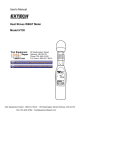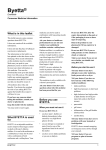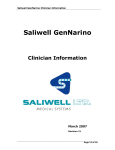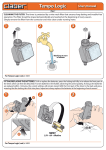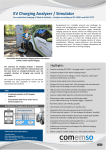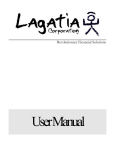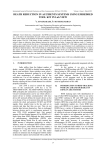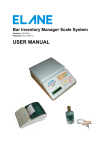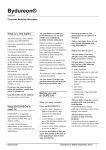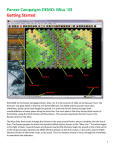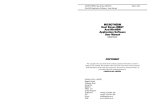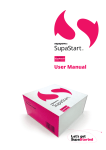Download Heat Stress WBGT Meter
Transcript
User's Manual Heat Stress WBGT Meter Model HT30 Introduction Congratulations on your purchase of Heat Stress WBGT (Wet Bulb Globe Temperature) Meter. This meter measures and displays Heat Stress Index (WBGT), which is how hot it feels when humidity is combined with temperature, air movement, and direct or radiant sunlight. Black Globe Temperature (TG) monitors the effects of direct solar radiation on an exposed surface. It also measures air temperature (TA) and Relative Humidity (RH). Additional features include: selectable units of °F/°C, Auto power off with override, and a built-in RS-232 interface with optional 407752 Windows® software. This meter is shipped fully tested and calibrated and, with proper use, will provide years of reliable service. Meter Description 1. Black Globe temperature sensor 2. RH and Temperature sensors with protective cover 3. LCD display 4. /SET 5. NEXT 6. MODE/ 7. RS-232 interface 8. Battery compartment (on rear) DISPLAY Symbol Function WBGT Wet Bulb Globe Temperature TG Black Globe Temperature TA Air Temperature RH% Relative Humidity OUT Indoor (no sun) IN Outdoor (in full sun) C/F Celsius/Fahrenheit Low Battery indicator 2 HT30-en-GB_V3.5 9/15 Meter Operation 1. 2. Press the /SET button to power the instrument on/off. Slide down the protective sensor cover before taking measurements. 3. Press the MODE/button to select the desired display mode: Wet Bulb Globe Temperature Heat Index (WBGT), Air Temperature (TA), Black Globe Temperature (TG), or Relative Humidity (RH). An icon will appear in the display indicating the current selection. To select the preferred temperature unit (°F or °C), simultaneously press and release the MODE/and NEXT buttons. The F or C icon will appear in the display. The meter measures WBGT index with (IN) or without (OUT) direct sun exposure. Hold down the MODE/ for more than 1 second to alternate between settings. The IN or OUT icon will appear in the display. 4. 5. Alarm Setting The HT30 has a user settable heat stress index alarm. The HT30 will emit an audible beep when the heat stress index (WBGT) reaches the level previously set by the user. The alarm will continue beep until the measured heat stress index temperature falls below the alarm level set by the user, or the meter is turned off. The setting range is from 68.0 to 99.0°F (20.0 to 37.2°C). 1. 2. To enter the alarm setup mode, hold down the /SET button for more than 2 seconds when turning the meter on. The current alarm setting will be displayed with the most significant digit blinking. Use the MODE/button to increment the digit. To set the next digit, momentarily press the NEXT button. After all of the digits are set, press and hold the NEXT button for 2 seconds to return to the measuring mode. NOTE: The OUT icon will appear in the display If the new setting is out of the setting range of the alarm. 3. 4. 5. 3 HT30-en-GB_V3.5 9/15 Auto Power Off The Auto Power Off feature automatically turns the meter off after approximately 20 minutes. To disable this feature, hold down the /SET and MODE/for 2 seconds when powering on the meter. The meter will momentarily display an “n” and enter measuring mode. The meter will reset to auto power off mode when it is powered off. Battery Replacement When it is time to replace the batteries, the low battery indicator corner of the LCD display. To replace the battery: 1. Open the battery compartment on the back of the meter. 2. Replace the two AAA batteries and close the compartment. appears in the bottom left-hand 3. You, as the end user, are legally bound (Battery ordinance) to return all used batteries and accumulators; disposal in the household garbage is prohibited! You can hand over your used batteries / accumulators at collection points in your community or wherever batteries / accumulators are sold! Disposal: Follow the valid legal stipulations in respect of the disposal of the device at the end of its lifecycle RS-232 PC Interface The RS-232 serial data port (3.5mm phono jack) is located on the right side of the meter. The PC interface hardware is intended for use with the Extech software package, Part Number 407752 ® which includes Windows compatible software and PC interface cable. This software will allow you to Stream data from the meter to the PC software (Data Acquisition). For more information, contact Extech or refer to the 407752 User's Manual. Error Messages An error message will appear on the display if the meter fails an internal diagnostic test. 1. E2: The value is under range. 2. E3: The value is over range. 3. E4: The value is in error. 4. E11: RH Calibration error. 5. E33: Circuit error. Repair/replacement necessary. 4 HT30-en-GB_V3.5 9/15 Specifications Wet Bulb Globe Temperature (WBGT) 0°C to 50°C (32°F to 122°F) WBGT Accuracy Calculated from measured parameters TG Black Globe Temperature range 0 to 80°C (32°F to 176°F) TG Accuracy ±2°C (4°F) Indoor Outdoor ±3°C (5.5°F) TA Air Temperature range 0°C to 50°C (32°F to 122°F) TA Accuracy ±1°C (1.8°F) Relative Humidity (RH) 0 to 100%RH RH Accuracy ±3% (at 25°C, 10 to 95%RH) Resolution 0.1°F/°C; 0.1%RH Operating Temperature 0°C to 50°C (32°F to 122°F) Operating Humidity Max. 80% RH Power Supply Two AAA batteries Battery Life Approx 1000 hours Dimensions Meter: 254 x 48.7 x 29.4mm (10x1.9x1.1") Black Ball: 40mm, 35mm (1.57 Dia., 1.37H) Weight 136g (4.8oz) Optional Accessories PC software and cable (407752) 5 HT30-en-GB_V3.5 9/15 APPENDIX The following is reprinted with permission of the National Oceanic and Atmospheric Administration. A National Problem Heat kills by taxing the human body beyond its abilities. In a normal year, about 175 Americans succumb to the demands of summer heat. Among the large continental family of natural hazards, only the cold of winter -- not lightning, hurricanes, tornadoes, floods, or earthquakes -- takes a greater toll. In the 40-year period from 1936 through 1975, nearly 20,000 people were killed in the United States by the effects of heat and solar radiation. In the disastrous heat wave of 1980, more than 1,250 people died. And those are the direct causalities. No one can know how many more deaths are advanced by heat wave weather -- how many diseased or aging hearts surrender, that under better conditions would have continued functioning. North American summers are hot; most summers see heat waves in one section or another of the United States. East of the Rockies, they tend to combine both high temperatures and high humidity although some of the worst have been catastrophically dry. Considering this tragic death toll, the National Weather Service has stepped up its efforts to alert more effectively the general public and appropriate authorities to the hazards of heat waves -- those prolonged excessive heat/humidity episodes. Based on the latest research findings, the NWS has devised the "Heat Index" (HI), (sometimes referred to as the "apparent temperature"). The HI, given in degrees Fahrenheit, is an accurate measure of how hot it really feels when the relative humidity (RH) is added to the actual air temperature. To find the Heat Index, look at the Heat Index Chart. As an example, if the air temperature is 95°F (found on the left side of the table), and the relative humidity is 55% (found at the top of the table), the HI -- or how hot it really feels -- is 110°F. This is at the intersection of the 95° row and the 55% column. Important: Since HI values were devised for shady, light wind conditions, exposure to full sunshine can increase HI values by up to 15°F. Also, strong winds, particularly with very hot, dry air, can be extremely hazardous. Note on the HI chart the shaded zone above 105°F. This corresponds to a level of HI that may cause increasingly severe heat disorders with continued exposure and/or physical activity. 6 HT30-en-GB_V3.5 9/15 Heat Index / Heat Disorders Heat Index / Heat Disorders Heat Index Possible heat disorders for people in higher risk groups 130°F or higher Heatstroke/sunstroke highly likely with continued exposure. 105° 130°F Sunstroke, heat cramps or heat exhaustion likely, and heatstroke possible with prolonged exposure and/or physical activity. 90° 105°F Sunstroke, heat cramps and heat exhaustion possible with prolonged exposure and/or physical activity. 80° - 90°F Fatigue possible with prolonged exposure and/or physical activity. The "Heat Index/Heat Disorders" table relates ranges of HI with specific disorders, particularly for people in the higher risk groups. How Heat Affects the Body Human bodies dissipate heat by varying the rate and depth of blood circulation, by losing water through the skin and sweat glands, and -- as the last extremity is reached -- by panting, when blood is heated above 98.6 degrees. The heart begins to pump more blood, blood vessels dilate to accommodate the increased flow, and the bundles of tiny capillaries threading through the upper layers of skin are put into operation. The body's blood is circulated closer to the skin's surface, and excess heat drains off into the cooler atmosphere. At the same time, water diffuses through the skin as perspiration. The skin handles about 90 percent of the body's heat dissipating function. Sweating, by itself, does nothing to cool the body, unless the water is removed by evaporation -- and high relative humidity retards evaporation. The evaporation process itself works this way: the heat energy required to evaporate the sweat is extracted from the body, thereby cooling it. Under conditions of high temperature (above 90 degrees) and high relative humidity, the body is doing everything it can to maintain 98.6 degrees inside.The heart is pumping a torrent of blood through dilated circulatory vessels; the sweat glands are pouring liquid -- including essential dissolved chemicals, like sodium and chloride -- onto the surface of the skin. Too Much Heat Heat disorders generally have to do with a reduction or collapse of the body's ability to shed heat by circulatory changes and sweating, or a chemical (salt) imbalance caused by too much sweating. When heat gain exceeds the level the body can remove, or when the body cannot compensate for fluids and salt lost through perspiration, the temperature of the body's inner core begins to rise and heat-related illness may develop. Ranging in severity, heat disorders share one common feature: the individual has overexposed or overexercised for his/her age and physical condition in the existing thermal environment. Sunburn, with its ultraviolet radiation burns, can significantly retard the skin's ability to shed excess heat. Studies indicate that, other things being equal, the severity of heat disorders tend to increase with age -- heat cramps in a 17-year-old may be heat exhaustion in someone 40, and heat stroke in a person over 60. Acclimatization has to do with adjusting sweat-salt concentration, among other things. The idea is to lose enough water to regulate body temperature, with the least possible chemical disturbance. Cities Pose Special Hazards The stagnant atmospheric conditions of the heat wave trap pollutants in urban areas and add the stresses of severe pollution to the already dangerous stresses of hot weather, creating a health problem of undiscovered dimensions. A map of heat-related deaths in St. Louis during 1966, for example, shows a heavier concentration in the crowded alleys and towers of the inner city, where air quality would also be poor during a heat wave. The high inner-city death rates also can be read as poor access to air-conditioned rooms. While air-conditioning may be a luxury in normal times, it can be a lifesaver during heat wave conditions. The cost of cool air moves steadily higher, adding what appears to be a cruel economic side to heat wave fatalities. Indications from the 1978 Texas heat wave suggest that some elderly people on fixed incomes, many of them in buildings that could not be ventilated without air conditioning, found the cost too high, turned off their units, and ultimately succumbed to the stresses of heat. 7 HT30-en-GB_V3.5 9/15 Know These Heat Disorder Symptoms Heat Disorder Symptoms First Aid Sunburn Redness and pain. In severe cases, swelling of skin, blisters, fever, headaches. Ointment for mild cases if blisters appear. If breaking occurs, apply dry sterile dressing. Serious, extensive cases should be seen by a physician. Heat Cramps Painful spasms usually in muscles of legs and abdomen possible. Heavy sweating. Firm pressure on cramping muscles, or gentle massage to relieve spasm. Give sips of water. If nausea occurs, discontinue use. Heat Heavy sweating, weakness, skin cold, Exhaustion pale and clammy. Pulse thready. Normal temperature possible. Fainting and vomiting. Get victim out of sun. Lay down and loosen clothing. Apply cool wet cloths. Fan or move victim to air conditioned room. Sips of water. If nausea occurs, discontinue use. If vomiting continues, seek immediate medical attention. Heat Stroke (or sunstroke) Heat stroke is a severe medical emergency. Summon medical assistance or get the victim to a hospital immediately. Delay can be fatal. High body temperature (106°F, or higher). Hot dry skin. Rapid and strong pulse. Possible unconsciousness. Move the victim to a cooler environment. Reduce body temperature with cold bath or sponging. Use extreme caution. Remove clothing, use fans and air conditioners. If temperature rises again, repeat process. Do not give fluids. WARNING: Sudden temperature and humidity changes (e.g. going indoors to outdoors) may cause inaccurate Temperature, Humidity and Heat Index readings for up to 45 minutes. Until readings stabilize (e.g. stop steadily increasing or decreasing), users should NOT rely on the Temperature, Humidity or Heat Index readings of this meter, or on the meter’s alarm function in regards to such readings. This meter is NOT a medical device and users should NEVER rely on readings for medical purposes. 8 HT30-en-GB_V3.5 9/15 Preventing Heat-Related Illness Elderly persons, small children, chronic invalids, those on certain medications or drugs (especially tranquilizers and anticholinergics), and persons with weight and alcohol problems are particularly susceptible to heat reactions, especially during heat waves in areas where moderate climate usually prevails. Heat Wave Safety Tips Slow down. Strenuous activities should be reduced, eliminated, or rescheduled to the coolest time of the day. Individuals at risk should stay in the coolest available place, not necessarily indoors. Dress for summer. Lightweight, light-colored clothing reflects heat and sunlight, and helps your body maintain normal temperatures. Put less fuel on your inner fires. Foods (like proteins) that increase metabolic heat production also increase water loss. Drink plenty of water or other nonalcoholic fluids. Your body needs water to keep cool. Drink plenty of fluids even if you don't feel thirsty. Persons who (1) have epilepsy or heart, kidney, or liver disease, (2) are on fluid restrictive diets, or (3) have a problem with fluid retention should consult a physician before increasing their consumption of fluids. Do not drink alcoholic beverages. Do not take salt tablets unless specified by a physician. Persons on salt restrictive diets should consult a physician before increasing their salt intake. Spend more time in air-conditioned places. Air conditioning in homes and other buildings markedly reduces danger from the heat. If you cannot afford an air conditioner, spending some time each day (during hot weather) in an air conditioned environment affords some protection. Don't get too much sun. Sunburn makes the job of heat dissipation that much more difficult. Copyright © 2013‐2015 FLIR Systems, Inc. All rights reserved including the right of reproduction in whole or in part in any form ISO‐9001 Certified www.extech.com 9 HT30-en-GB_V3.5 9/15









